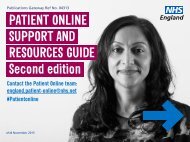Focus on Bullying and Mental Health
VttyL
VttyL
You also want an ePaper? Increase the reach of your titles
YUMPU automatically turns print PDFs into web optimized ePapers that Google loves.
By the age of 12, 2.9% of participants had self-harmed, however<br />
over half of those that did also reported being a victim of frequent<br />
bullying. After c<strong>on</strong>trolling for multiple pers<strong>on</strong>al <strong>and</strong> family risk<br />
factors, children who were victimised were around 3 times more<br />
likely to self-harm than those who had not been victimised.<br />
Another study followed children from birth, assessing whether<br />
participants had experienced bullying at school at age 12, <strong>and</strong><br />
whether they engaged in self-harming at age 15 16 . Many<br />
pers<strong>on</strong>al <strong>and</strong> situati<strong>on</strong>al characteristics were associated with a<br />
greater likelihood of self-harming, including being female, having<br />
emoti<strong>on</strong>al <strong>and</strong> behavioural problems, having parental illness, <strong>and</strong><br />
having an absent parent, however, after c<strong>on</strong>trolling for all these<br />
factors, being bullied independently increased the likelihood of<br />
children c<strong>on</strong>sidering self-harming. Only 2% of n<strong>on</strong>-victims had<br />
c<strong>on</strong>sidered self-harm, compared to over 9% of victims.<br />
Picking up <strong>on</strong> this finding, researchers began to explore the<br />
pathways through which bullying, in combinati<strong>on</strong> with other risk<br />
factors, can lead to children self-harming. Using a sample of 4,810<br />
UK children 17 , bullying was assessed between the ages of 7 to 10,<br />
<strong>and</strong> self-harming at age 16. The authors found that bullying al<strong>on</strong>e<br />
increased the risk of children self-harming, but furthermore, had<br />
an indirect influence, by causing children to become depressed,<br />
<strong>and</strong> then in turn, self-harming as a way of dealing with the<br />
depressi<strong>on</strong>. Additi<strong>on</strong>ally, family risk factors, including maladaptive<br />
parenting <strong>and</strong> domestic violence were linked to self-harming via<br />
bullying: exposure to an aggressive home envir<strong>on</strong>ment increased<br />
the risk of children self-harming, but this was further intensified if<br />
the child also experienced bullying at school.<br />
In additi<strong>on</strong> to<br />
self-harm, there<br />
appears to be a<br />
clearly increased<br />
risk of suicide<br />
am<strong>on</strong>g children<br />
who are bullied<br />
at school<br />
In additi<strong>on</strong> to self-harm, there appears to be a clearly increased<br />
risk of suicide am<strong>on</strong>g children who are bullied at school. A metaanalysis<br />
of 37 mainly cross-secti<strong>on</strong>al studies 18 , combined multiple<br />
findings from different countries <strong>and</strong> settings, c<strong>on</strong>cluding that<br />
any participati<strong>on</strong> in school bullying, whether as a bully, victim,<br />
or bully-victim, significantly increased the risk of suicidal ideati<strong>on</strong><br />
or behaviours across a broad spectrum of children <strong>and</strong><br />
young people.<br />
While many studies fail to address other factors within children’s<br />
lives which may additi<strong>on</strong>ally c<strong>on</strong>tribute towards their suicidal<br />
feelings or behaviour, <strong>on</strong>e UK study of 6,000 children 19 examined<br />
suicidal ideati<strong>on</strong> at age 11, <strong>and</strong> bullying involvement from ages<br />
4-10, while c<strong>on</strong>trolling for multiple individual <strong>and</strong> family risk factors.<br />
All roles in bullying were linked with a str<strong>on</strong>ger likelihood of<br />
suicidal ideati<strong>on</strong> <strong>and</strong> behaviour; both victims <strong>and</strong> bully-victims<br />
were 2 to 3 times more likely than children not involved in bullying<br />
to think about or attempt suicide. Furthermore, children who<br />
bullied others showed a threefold increase in the likelihood of<br />
suicidal ideati<strong>on</strong> <strong>and</strong> behaviour. The authors c<strong>on</strong>clude that<br />
irrespective of any pre-existing risk factors, involvement in bullying,<br />
particularly that which is frequent <strong>and</strong> prol<strong>on</strong>ged, substantially<br />
increases the risk of suicidal or self-harming thoughts <strong>and</strong><br />
behaviour in adolescence.<br />
<str<strong>on</strong>g>Focus</str<strong>on</strong>g> <strong>on</strong>: <strong>Bullying</strong> <strong>and</strong> <strong>Mental</strong> <strong>Health</strong> 7




